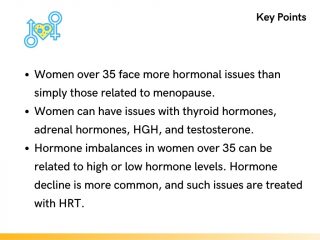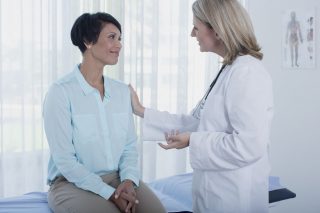Common Hormone Problems for Women After 35: Symptoms and Causes

Women can face hormonal issues as young as 35.
Women do not have to be going through menopause to experience physical, emotional, and mental issues related to hormonal changes. There is not a specific age at which menopause begins. Menopause technically starts once a woman is no longer fertile and is not going through her regular menstrual cycles. That usually happens around the age of 50 or so, but women can experience hormone-related issues long before that.
There are a number of hormonal problems that women face after 35, and only some of them are related to menopause. For example, thyroid disorders, adrenal fatigue, and Polycystic Ovary Syndrome (PCOS) can and do happen during the reproductive years, and “perimenopause” or “pre-menopausal” symptoms can occur while a woman is still menstruating and has yet to entire full-blown menopause.
Thyroid Disorders
The thyroid gland releases two different thyroid hormones, triiodothyronine (T3) and thyroxine (T4). These hormones play a vital role in the regulation of your weight, energy levels, internal temperature, tolerance to external temperatures, as well as metabolism and skin and hair health. Both men and women can suffer from thyroid hormone issues, but thyroid problems are more common in women, especially once they are over 35.
Thyroid hormone issues can create two distinct problems – hypothyroidism and hyperthyroidism. In hypothyroidism, a woman’s body is not producing enough thyroid hormone. Hyperthyroidism, on the other hand, is when the thyroid is putting out too much thyroid. Hypothyroidism (low levels of thyroid hormone) is the more common of the two in women over 35.
Thyroid issues are complex. Women can suffer from either too much or too little thyroid hormone, and the symptoms and treatment plans differ for each. Depending on your medical history, your presenting symptoms, and the results of hormone testing, treatment for thyroid hormone issues could include iodine supplements oral thyroid replacement hormones, along with diet, exercise, and lifestyle changes.
Perimenopause and Menopause

Menopause usually occurs after the age of 45. It is the time in a woman’s life when she is no longer able to have children. While the exact age of the onset of menopause can vary, it is technically defined as the point in time 12 months after a woman’s last period.
The time leading up to that point is known as perimenopause. It is during this time when a woman tends to start to experience the debilitating symptoms of menopause – hot flashes, night sweats, trouble sleeping, moodiness and irritability, pain during sex, and/or depression.
These symptoms are caused by the severe hormonal changes that occur once a woman’s ovaries are no longer producing eggs. During her childbearing years, the ovaries produce and release the female hormones progesterone and estrogen. Just before, during, and after menopause, the production of these hormones significantly decreases. Women’s bodies produce and also need testosterone. Testosterone levels also significantly drop once a woman reaches menopause.
The standard of care to treat menopause symptoms is hormone replacement therapy or HRT. Despite some recent controversies, HRT remains the most effective treatment available for treating the worst symptoms of menopause.
With what doctors have learned over the last several decades, we are now much smarter about how to prescribe HRT for women. At our clinics, we look very closely at each woman as an individual, evaluate her symptoms and hormone levels, and prescribe just the right, safe, and effective hormone treatments to get her back into her optimal balance.
Estrogen Dominance
Most of the time, when we talk of hormonal disorders or imbalances, especially when we are discussing menopause, we think of a woman’s body making too little of a particular hormone. But as we have already learned with thyroid hormones, too much of a given hormone can sometimes be just as troubling as not making enough. Believe it or not, that is also the case with estrogen. There is a condition where a woman has a high estrogen level. This is often referred to as a patient with “unopposed estrogen” or “estrogen dominance.”
As you probably know, there are two female hormones that are critical to fertility and the reproductive cycle — progesterone and estrogen. These two hormones must work together in a proper balance for a woman to ovulate regularly, have normal periods, and maintain good reproductive health. Progesterone acts as a kind of estrogen antagonist, keeping estrogen levels from rising out of control. But when something throws off this balance, and progesterone levels drop significantly, then estrogen dominates, and a woman’s estrogen level can be too high. In pre-menopausal women, estrogen dominance is probably caused by Polycystic Ovary Syndrome (PCOS); otherwise, the likely cause is menopause and menopause-related weight gain.
In women, estrogen dominance can cause irregular periods, fertility issues, and sore or tender breasts. Estrogen dominance in women also can increase the risk of breast cancer, ovarian cancer, and endometriosis.
Adrenal Fatigue

“Adrenal fatigue” is a term applied to a collection of nonspecific symptoms, such as body aches, fatigue, nervousness, sleep disturbances, and sexual problems.
The adrenaline glands produce hormones that are all related to how our bodies react to stress, such as cortisol and epinephrine. These hormones are essential to your “fight or flight reaction.” When you are in a stressful situation, these hormones are released in a burst for you to deal with the situation, and then when the threat has passed, the levels return to normal. However, when you are exposed to a state of chronic stress, as many women over 35 are, your adrenals are overworked and can “burn out,” causing the symptoms associated with adrenal fatigue.
Since the root cause of adrenal fatigue in women is stress, taking measures to reduce stress can return the adrenals to normal function and is often all that is needed to reverse these symptoms.
Polycystic Ovary Syndrome (PCOS)
Polycystic Ovary Syndrome, or PCOS, is a hormonal issue that happens to women long before menopause. In fact, it is restricted to the reproductive years, and it causes women to have issues with their menstrual cycles. In PCOS, you can have irregular periods or periods that last longer than normal.
It is really not known what exactly causes PCOS, but what occurs are cysts that form along the ovaries that prevent them from releasing eggs as they should. This is why PCOS affects menstrual cycles. Because of how it impacts normal ovarian function, women with PCOS will have hormone imbalances, often including higher than normal testosterone levels. This can lead to excessive body hair and acne.
Specific treatments for PCOS depend on your medical history and presenting symptoms.
Impact of Hormone Problems on Women’s Health after 35

As you can see, women need to be aware of the many hormonal issues that they can face between the ages of 35 and 65. Depending on the hormones involved, hormone issues in women over 35 can cause weight gain, menopausal symptoms, sexual health problems, and even hair loss!
Importance of Testosterone and HGH for Women
Testosterone and human growth hormone (HGH) can be just as important to women as they are to men. As in men, both hormones decline as a woman ages. Age-related growth hormone decline and low testosterone in women cause some of the same problems as they do in men, as well as some issues unique to females.
Low Testosterone in Women
While testosterone is a male hormone, a woman’s body makes and needs testosterone as well. As mentioned above, women with PCOS could have a problem with high testosterone levels, but low testosterone in women is the far more common problem, especially as they approach the menopausal years. Just as in men, women lose the ability to produce testosterone as they age. Clinical research and medical practice are beginning to recognize the important role that testosterone replacement therapy plays for women, particularly in the relief of many of the most debilitating symptoms of menopause.
As a woman approaches pre-menopausal age, her testosterone level can be significantly reduced. Once a woman enters menopause, her testosterone level could be less than half of what it was during her childbearing years.
The symptoms of low testosterone in women include:
- Fatigue.
- Muscle loss.
- Weight gain.
- Low libido and other sexual health issues.
- Difficulty with focus, concentration, and other cognitive issues.
As in men, the treatment of low testosterone in women involves testosterone replacement therapy (TRT). Studies have found that TRT can be very effective for women. For example, A Study published in The Journal of Clinical Endocrinology & Metabolism found that “There is increasing evidence to suggest that many postmenopausal women experience symptoms alleviated by [testosterone] therapy and that such symptoms may be [a result of] testosterone deficiency.
HGH Therapy for Women
One of the most serious issues caused by estrogen loss as women approach and enter menopause is a loss of bone density and an increased risk of osteoporosis. Typical menopause treatments of estrogen replacement have been shown to slow or reverse this bone loss. In addition to traditional HRT, multiple research studies have shown that HGH injections can be quite effective in increasing bone density and reducing the risk of osteoporosis and osteoporosis-related fractures in women.
For example, a study published in the Endocrine Society’s Journal of Clinical Endocrinology & Metabolism found that for many years after it was given, HGH continued to reduce the risk of fractures and helped maintain bone density in postmenopausal women who had osteoporosis.
Research has also proven that the results of HGH, when used in conjunction with traditional HRT for women, can have significant benefits beyond bone health. With its known ability to enhance cellular rejuvenation and tissue growth, HGH’s anti-aging effects have been well documented, and HGH therapy can be very helpful in improving hormonal issues and overall health in women over 35. If you would like to know a little bit more about HGH therapy, please take a look at our HGH for Sale page.
When to Seek Professional Help?
Because of the many health concerns — some quite severe – that can be caused by hormonal imbalances in women, if you are over 35 and find yourself tired, putting on weight, having irregular menstrual cycles, sexual health issues, or any of the many symptoms of hormonal issues we’ve discussed on these pages, it’s important you seek medical help. With adequate therapies, most, if not all, of the issues of hormonal imbalance in women can be reduced or reversed. But as with any kind of medical intervention, the sooner you seek treatment, the more successful it will be.
How Are Menopause and Other Hormonal Issues Treated in Women?
Since most of the hormonal issues in women 35 and over are related to declining hormone levels, the most common treatment to return hormones to their proper balance is some form of hormone replacement therapy.
Conclusion
So many of a woman’s bodily processes are regulated by hormones, which makes her particularly susceptible to hormonal issues. However, once women over 35 are aware of the various problems hormone imbalances can cause, learn how to recognize the symptoms, and seek treatment, they can control hormone issues instead of letting their hormones control them!

